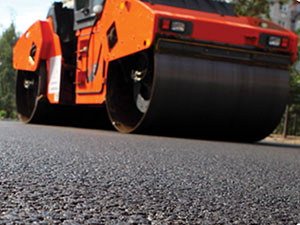Rebuilding stronger, less expensive roads with recycled asphalt

While the eco-friendly mantra "reduce and reuse” has been around for decades, its role in asphalt pavement rehabilitation has been discovered much more recently. In years past, when an asphalt road began to deteriorate, the answer was either to apply a hot-mix asphalt overlay to the road’s surface or perform a complete reconstruction of the pavement.
“The problem is that other options should be considered,” says University of Minnesota civil engineering professor Joseph Labuz. “Fully reconstructing a road is expensive and time consuming, and though the overlay method is fast and less expensive, it doesn’t always provide a lasting solution because previous distresses and cracks eventually make their way up to the new layer of pavement.”
As an alternative to these two methods, in-place asphalt recycling continues to gain popularity. Full-depth reclamation (FDR) is a pavement recycling technique in which the existing pavement and some of the existing base layer are broken up and blended to form an improved base for a new asphalt surface. Sometimes an additive is mixed in with the recycled pavement layer to further increase its stability, which is known as stabilized full-depth reclamation (SFDR).
As FDR and SFDR gain popularity, highway engineers need ways to effectively evaluate their properties and correctly apply pavement design guidelines. Few documented field studies have measured material performance, however, so assigning the proper design values to FDR and SFDR pavements is done conservatively.
To provide engineers with more guidance, the Minnesota Department of Transportation (MnDOT) sponsored a U of M study to estimate the proper design values and assess the effects of seasonal temperature changes on these pavements.
There's no need to haul in aggregate or haul out old material for disposal using full-depth reclamation. And recycling normally costs up to 50% less than when old pavement is removed and replaced.
“MnDOT uses granular equivalency (GE) to describe stiffness of asphalt and base materials,” says Shongtao Dai, research operations engineer with MnDOT’s Office of Materials and Road Research. When this project was initiated in 2009, there was no well-defined method to determine GE, he explains, and MnDOT recommended a GE of 1.0 (equivalent to a “class 5” aggregate).
Over three years, the U of M research team led by Labuz evaluated tests performed by MnDOT to determine the stiffness of seven sections of FDR and SFDR county roads in Minnesota. During the spring thaw of each year, tests were conducted daily during the first week of thawing to document seasonal weakening of the pavement’s base layer. After the spring thaw period, tests were conducted monthly at each location to capture the pavement strength changes throughout the season.
The study results demonstrate the benefits of SFDR pavements in particular: SFDR pavements were determined to have a higher “stiffness rating” than had previously been assigned by MnDOT, and GE was estimated at about 1.5—meaning less expensive aggregates could beconsidered. In addition, while both pavement types exhibited the seasonal effects typical for asphalt pavements—lower stiffness in the spring than in the summer and fall—most of the SFDR pavements showed improved seasonal stiffness.
“The research has provided guidance and confidence to MnDOT on determining GE values for SFDR materials,” Dai says.
Brian Noetzelman, county engineer of Pope County and a member of the project advisory panel, adds that if the GE for SFDR rose from 1.0 to 1.5, it would give 50 percent more carrying capacity to the existing base GE at a minimal cost. “Current 9-ton designs could now be 10-ton designs with the same design structure. What a tremendous savings for counties!”
Reprinted with permission from the June 2013 issue of CTS Catalyst, a publication of the University of Minnesota's Center for Transportation Studies.
